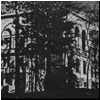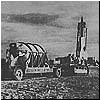|
|
|
Searching for details: The author will appreciate receiving eyewitness accounts, recollections and documents related to the involvement of German citizens in the Soviet rocket program, as well as comments on already published material. Please contact Anatoly Zak. Related pages: Acknowledgments: This section became possible thanks to the help of the following individuals: Boris Chertok of RKK Energia; Yuri Mozhorin and Anatoly Eremenko of TsNIIMash; Yuri Demyanko of Keldush Center; Boris Yezhov of Korolev Historical Museum; Valery Bukreev of Zvezda Enterprise; Aleksey Vasiliev of the Ostashkov Historical Museum; Igor Barmin of KBOM; Bernd Falkenmayer, one of Gorodomlya veterans.
|
GERMAN LEGACY IN THE SOVIET ROCKETRY | |||||||
|
During World War II, the Nazi regime in Germany funded an unprecedented effort to build rocket weapons. Capitalizing on the experience accumulated by German rocket enthusiasts since the second half of the 1920s, a group of engineers at a secret center in Peenemunde developed a ballistic missile of incomparable size and range. Officially dubbed Vergeltungswaffe-2, or "vengeance weapon-2," the cigar-shaped rocket could reach targets more than 300 kilometers away. The A-4 became a paramount of a multi-fold rocket development program, which also included antiaircraft and cruise missiles, as well as piloted rocket-propelled fighter planes. Although all this technology could not prevent German defeat in World War II, allied nations fighting Germany, paid close attention to the emerging rocketry. Ultimately, the A-4 technology became a root of the missile development programs in the US, Russia and China. |
||||||||
|
By May 1943, after years of skepticism, British intelligence was finally convinced in the existence of the German long-range ballistic missile program. On July 13, 1944, the British Prime-Minister Winston Churchill, reportedly for the first time informed Joseph Stalin about German secret rocket weapon tested near the town of Debica in Poland. This letter apparently prompted Stalin to initiate the earliest Soviet effort to obtain German rocket technology. |
||||||||
|
During 1945 and most part of 1946, 284 Soviet specialists worked in Germany, searching and restoring hardware and documentation related to the A-4 and other German missiles. In 1946, with the help of numerous German engineers and workers, the Soviets reestablished the production line of the A-4 rocket, at the former repair plant, which turned out around dozen missiles. Live tests of rocket engines were re-started at Lehesten. Actual launches of the A-4 missiles in Germany were also under consideration, however citing the security concerns, the Soviet government ordered all further work on missile development to be transferred to the USSR. |
||||||||
| Birth
of the rocket industry
The extensive rocket development infrastructure in the wartime Germany hardly had any equivalent institution in the USSR. As a new field for the Soviet industry, rocket technology needed an organization, which could consolidate recovered rocket trophies and employ them in the future. After months of bickering between different industrial ministries, the Soviet government finally gave responsibility for the rocket program to the Ministry of Armaments led by Dmitry Ustinov. The official decision signed on May 13, 1946, also ordered the transfer of all research and development work on rockets from Germany to the Soviet Union. |
||||||||
 |
Germans
in Moscow
In October 1946, most experienced German specialists who worked for the Soviet missile program were ordered on the trains and sent to various locations in the USSR to assist in the organization of missile production and design. By the beginning of the 1947, Soviets completed the transfer of all works on rocket technology from Germany into secret locations in the USSR. |
|||||||
 |
Testing
of the A-4 (V-2) rocket in Kapustin Yar
In the fall of 1947, Soviet-German team launched 11 A-4 rockets near the village of Kapustin Yar in the steppes north of the Caspian Sea. |
|||||||
| Gorodomlya
Island
By June 1948, absolute majority of German rocket specialists ended up in the confines of the Gorodomlya Island on the Seliger Lake, north of Moscow. Here, they continued working on a number of projects of ballistic missiles and related technology, however none of German proposals went beyond preliminary design stage. To make matters worse, the volume of advance engineering tasks assigned by the Russians started dwindling and with it the morale of the German collective descended ever lower. By 1953, when Soviet authorities ordered mass repatriation of German specialists to their home country, most of them had been out of work on rocketry for years. |
||||||||
|
HARDWARE:
GERMAN R&D IN USSR |
||||||||
| G-1 (R-10)
A number of radical design improvements proposed by German engineers for the A-4 rocket came together in the G-1 rocket developed by the Gorodomlya team during 1948. The rocket, the first ever, would feature detachable warhead and load-bearing propellant tanks among many other innovations, which later appeared in Soviet designs. During 1949, another version of the rocket designated G-1M was proposed. It would use the body of the original G-1, but sport more powerful engine. |
||||||||
| G-2 (R-12)
The G-2 rocket was developed to the level of "avant-project" (preliminary design) during 1948 and 1949. It envisioned a two-stage vehicle, capable of delivering a one-ton payload to a distance of 2,000 - 2,500 kilometers. The rocket would be powered by a cluster of three engines borrowed from the G-1 (R-10) project and developing a total trust of around 100 tons. Each engine would have an individual turbopump. The rocket would not have steering gas thrusters. The flight control system would be also borrowed from the G-1 design. The rocket would be equipped with a separable warhead. A two-stage design was considered impractical at the time due to problems of flight control during stage separation. |
||||||||
| G-3
The project of the G-3 missile was considered on Gorodomlya Island during 1949-1950. It envisioned a two-stage vehicle with the range of 8,000 - 10,000 kilometers. The G-1-derived vehicle would carry a winged upper stage and capable of carrying between three and five tons of payload. |
||||||||
| G-4 (R-14)
In April 1949 Ustinov visited Gorodomlya Island and gave German group the same specifications set in NII-88 for the R-3: a missile with a range of about 3,000 kilometers, capable of carrying a three-ton warhead. The rocket, proposed by Germans, had a shape of a cone, 24 meters tall and 2.74 meters in diameter. The weight of the rocket structure (empty weight) was about seven tons, including the warhead of the assigned weight. A fully fueled rocket would weigh 70.85 tons on the launch pad. |
||||||||
| G-5 (R-15)
In parallel with the work on the G-4, another group at Gorodomlya proposed a completely different vehicle, able to meet Ustinov's requirements. Werner Albring and his associates proposed an unmanned bomber designated R-15 (G-5) and equipped with a ramjet engine. The vehicle would be launched by the G-1 or A-4 booster rocket, and upon reaching the height and speed necessary for the ignition of the ramjet, it would separate from the launcher. Then, the R-15 would level off at the altitude of about 15 km, from which it would cruise to the target 3,000 kilometers from the launch site. |
||||||||